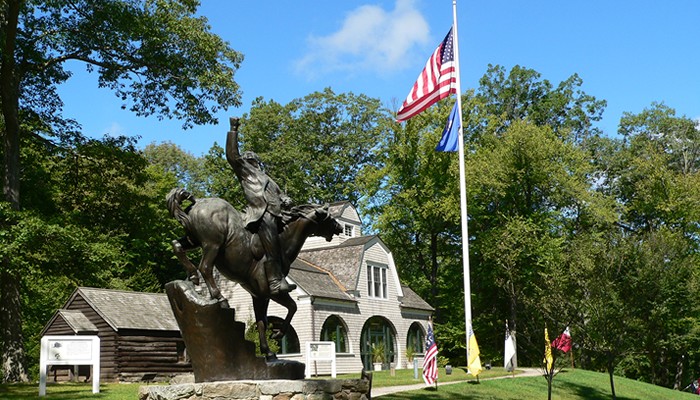Putnam Memorial State Park
Introduction
Text-to-speech Audio
Images
Monument to Israel Putnam, who served as a Major General during the American Revolution. It stands in front of the park's Visitor Center (Courtesy of the Putnam Memorial State Park)

This obelisk stands as a monument to the soldiers of the American Revolution who camped here during the winter of 1778-1779 (Courtesy of CT Monuments.net)

Backstory and Context
Text-to-speech Audio
By the winter of 1778-1779, the Continental forces were deep into the American Revolution. They needed to establish their winter camp and chose this site, now known as the Putnam Memorial State Park. The park is named for one of the four major generals who served under George Washington. Israel Putnam brought his group of men to Redding, Connecticut for the winter. The 2nd Canadian Regiment or Congress' Own, under the command of Moses Hazen and the 2nd New Hampshire Regiment under the command of Enoch Poor were also stationed at this location. Many of these men were the same who had suffered at Valley Forge the previous winter. Their job was to guard the supply storehouses in nearby Danbury, which other forces had already pilfered. In addition, they could use this site to protect Long Island Sound and the Hudson River Valley.
Major General Israel Putnam was near the end of a long, storied military career. A prosperous farmer during peacetime, he rallied to lead the revolutionary forces when he first heard about the battles commencing at Lexington and Concord. The patriot had previously helped to defend New England against the native people during the French and Indian War, about fifteen years earlier. He fought in attacks at Fort Ticonderoga and Montreal in 1759. Postwar, he had become an outspoken critic of British imposition and taxation, speaking out against things like the Stamp Act. He was heavily involved in the Sons of Liberty. In 1775, he was plowing his fields when he heard about the shots fired in Lexington and Concord. He reportedly dropped his tools and rushed off to fight for the patriot cause. He led forces in the Battle of Bunker Hill and then in New York at Long Island and in the Hudson Valley. Eventually, he was put in charge of guarding the storehouse in southwestern Connecticut.
A paralyzing stroke in December 1779 ended Putnam’s military career. He died in Brooklyn, Connecticut in 1790. Almost a century later, the Putnam Memorial State Park was established in honor of Putnam and his men who spent the winter in the camp. It was the first state park established in the state of Connecticut (established prior to the creation of the Park’s department). Local historian and Redding resident, Charles Burr Todd, was instrumental in converting the land into a state park in 1887. In addition to the recreations of the forts and encampments, there are several monuments placed throughout the grounds. The monuments include several Civil War cannons, and obelisk, and a statue of Major General Putnam riding a horse down a staircase, in an apparent attempt to escape the British forces in Greenwich. Sculptor Anna Hyatt Huntington created the amazing piece for the park in 1967. Today, there are many activities available at the park for its visitors, including re-enactments, the winter walk, school programs, a museum, and archaeological digs.
Cite This Entry
von Jena, Kathleen and Erin Ritz. "Putnam Memorial State Park." Clio: Your Guide to History. September 10, 2017. Accessed March 14, 2025. https://theclio.com/entry/24578
Sources
Park History. Putnam Memorial State Park. Accessed September 09, 2017. http://putnampark.org/park-history/.
Putnam Memorial State Park - Redding. Connecticut Explorer: Traveling Connecticut, New England & New York. Accessed September 09, 2017. https://connecticutexplorer.blogspot.com/2013/10/putnam-memorial-state-park-redding.html.
Pelland, Dave. Putnam Memorial State Park, Redding. CT Monuments.Net: Connecticut History in Granite and Bronze. June 09, 2010. Accessed September 09, 2017. http://ctmonuments.net/2010/06/putnam-memorial-state-park-redding/.
Israel Putnam. United States History. Accessed September 10, 2017. http://www.u-s-history.com/pages/h1294.html.Hassan, Diane. A Celebrated Artist and a Meaningful Space – Today in History: October 20. ConnecticutHistory.Org. Accessed September 10, 2017. https://connecticuthistory.org/a-celebrated-artist-and-a-meaningful-space-today-in-history/.

